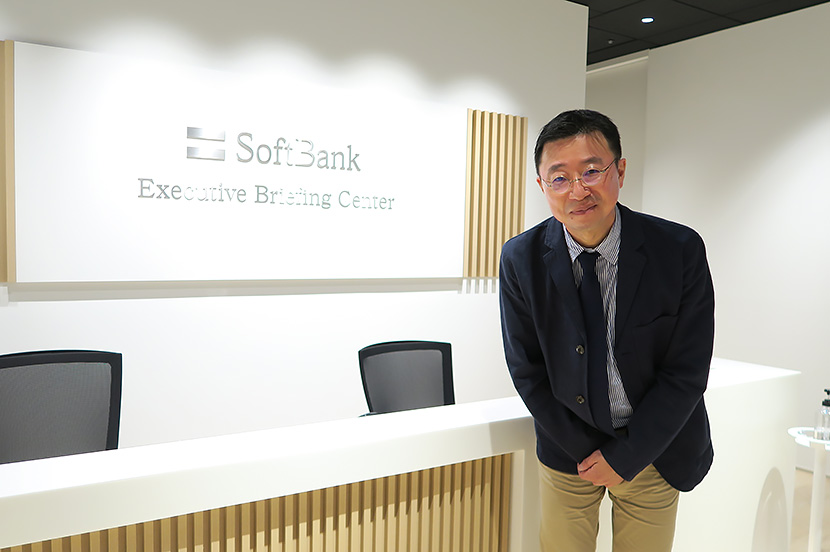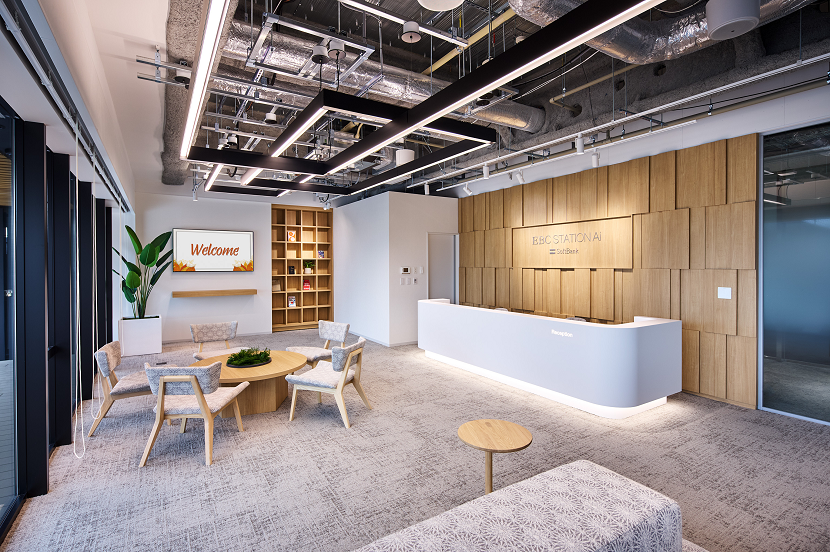
The center of the EBC: customers can open the doors on either side to technologies that interest them
To market more of its products, services and technologies, SoftBank Corp. (TOKYO: 9434) has taken a leaf out of literature. It has adapted the writer's Golden Rule of Show, Don't Tell and come up with the counter-intuitive Show, Don't Sell.
Presenting and demonstrating its technology expertise—minus the hard sell—is the intriguing business proposition behind the company's Executive Briefing Center (EBC) that opened June 1 in SoftBank's chic new headquarters in downtown Tokyo. While the state-of-the-art EBC showcases scores of advanced technologies and products from SoftBank and its partners, this is not a showroom you can walk into off the street. Access is by invitation only and for large enterprises. Typically, the invitation will come from a SoftBank sales account executive who is well familiar with the company and who knows the issues it is dealing with.
Technology's power to inspire thought
Upon arriving at the Center, the executives of Company X are ushered into a cozy reception area where, for a few minutes, they can relax unattended. Perhaps they will choose to browse the carefully chosen books laid out on several coffee tables—classics on technology with titles like Inevitable: Understanding the 12 Technological Forces That Will Shape our Future, The Algorithmic Leader, and Telecosm: The World After Bandwidth Abundance. Or they may prefer watching silent videos playing on wall displays showing content about their own company's accomplishments mixed with business news.

“Welcome to SoftBank's Executive Briefing Center.”
“The books I've chosen are titles to inspire thought on what technology can accomplish,” says Akira Tada, Director of the EBC. “The videos are tailored to customers' concerns and show we're interested in them, and that we know what they are about.”
Tada, a SoftBank veteran who has headed numerous initiatives with group companies and business partners, then leads the executives into the Square, a theater space with giant screens on three sides. Here, the executives are immersed in a video and light extravaganza that delivers the message: The future is here.
“The content is flexible and changes depending on the company and its situation,” explains Tada. “In our EBC team of 15, I have two video designers and four programmers. Together we create a show based on customer information gathered by the account executive and salespeople who regularly deal with the company.”

Theater content is customized to each customer's needs
Different technologies for different needs
The executives then enter a 30-meter-long passage with doors on either side that open on to various products and technologies from SoftBank and companies it collaborates with—over 50 in total. Here, the executives can have hands-on experience and watch live demonstrations and interactive presentations of technologies that could help solve the business challenges they face. They include the use of AI to enhance current technologies, 5G applications, initiatives for digital transformation (DX), and examples of how digital technologies are being employed in various use cases.
In one demonstration, Tada explains how SoftBank has improved the call center experience for both its customers and itself since implementing a new system. The AI software uses a special neural network to recognize the voices of customers and to convert voice-to-text in real time.
“This has a number of benefits for managers, call center operators and customers,” says Tada.
Managers can now monitor conversations visually. This helps them quickly evaluate customers' questions and operators' responses should problems arise; it enables concise feedback; and managers can pinpoint communication issues by scanning the text of what has previously been said. As for operators, when specified keywords are spoken, the software automatically displays the corresponding FAQs with answers on the operator's screen. This helps them respond faster to customers' queries.
“Not only do customers have a better experience, but such features reduce the time they are kept on hold,” says Tada. “The average length of a customer's call has been cut from 15 minutes to 12 minutes.”
He adds that because the system has helped SoftBank significantly improve its Call Center service, he hopes to convince customers who come to the EBC that SoftBank can help them do the same.

Another technology Tada demonstrates is the low latency of SoftBank's 5G network. Two robot arms located some 15 meters apart are hooked up to the 5G network. When Tada moves one arm manually and has it pick up a block, the other arm repeats the action in real time.
This kind of remote-operation technology could be used, for instance, in construction work performed in dangerous locations, as when conditions like hazardous materials, high temperatures, or extreme cold would prevent a human operator of a construction machine from working at the location directly. Instead, the operator could control the machine remotely using a screen to observe and manipulate its movements.
Another demonstration shows how a SoftBank subsidiary's technology combines face recognition with thermography and AI for use in a variety of ways. They include monitoring employees' comings and goings, including access to office buildings and facilities. Thus, the system eliminates the need for IC cards that can be lost, stolen, or used by a third-party impersonator. SoftBank has installed 20 units of the system at the entrance gates of its headquarters, where some 15,000 employees work.
A key feature of the technology—which boasts over 99 percent recognition accuracy, biometric detection and a scalable database—is that both face recognition and temperature detection can be performed simultaneously in less than half a second. This permits fast and smooth employee access while preventing unauthorized entry by strangers, and it audibly warns when someone has a high temperature. By adding IP cameras, additional features can be included such as video analytics for human attribute analysis to aid sales promotion.
No hard sell
After 30 or 40 minutes of such demonstrations, the executives are taken to an area reminiscent of a First-Class airport lounge.

Lounge

Boardroom
“Here we might discuss what the customers experienced, but in no way do I try and sell them anything,” says Tada. “My role is to show what the technology can do.”
Later, of course, the account executive will follow up and sound out the customers on their experience as well as present them with a report on what was presented. But that is about as overt as it gets, according to Tada. “The aim is to create an experience where the technology sells itself. So, if customers have a great experience and come away saying, ‘Wow!’ then I've done my job.”
Related Article
(Posted on August 10, 2021)
by SoftBank News Editors



